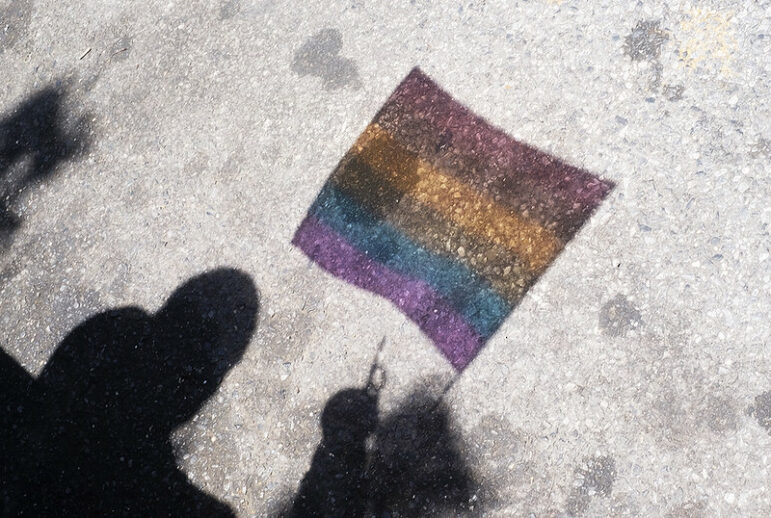“By not requiring schools to have genders and sexualities alliances, or pushing for inclusive curriculum in all schools, the DOE is refusing to take important steps proven to increase the health and safety of students.”

William Alatriste for the New York City Council
An LGBTQ flag reflected in pavement during the Queens Pride Parade.When Jasmine was a student at a middle school in Brooklyn, a group of boys regularly called her anti-LGBTQ+ slurs. Despite her frequent reports, school officials did nothing to stop them. Rather, they chose to disavow it with claims that she, a young queer student, was lying or overly dramatic. On her last day of middle school, she was jumped by a group of high school students that told her she was unnatural and that she should act more like a man. The response, from adults entrusted with providing education and a safe space to learn, made Jasmine hate herself, thinking there was something wrong with her, and that all of this was in fact her fault. She spent years in school alone, and hiding, unable to reveal herself for fear of what might happen.
Jasmine’s experience is not unique. While the first day of school can be anxiety-producing for many youth, students like Jasmine must contend with more than seeing friends or worrying about teachers—they must grapple with the crippling anxiety of accidentally being outed; an increased likelihood of being targeted on social media; and bias-driven practices from school staff that often show little to no support to queer and trans youth.
Every day, these young people are subjected to a toxic environment of threats, hate crimes, and bias. Those who are fortunate to have Gender & Sexuality Alliances (GSA) in their schools have the promise of a safe space, but thus far the city’s school system has failed to provide sufficient resources and support to make these a reality for every student. Moreover, none of the city’s schools have an inclusive curriculum that includes positive representation of LGBTQ+, making it more difficult for queer and trans youth to have positive associations with school.
According to the CDC’s 2021 Youth Risk Behavior Surveillance System, approximately 72.5 percent of youth in New York City identify as heterosexual, and with over a million students attending the city’s schools, approximately 300,000 non-heterosexual students make up the public school system. Of those LGBTQ+ youth, an estimated 25,000 to 40,000 are also experiencing homelessness.
The reality is that these statistics are likely significantly larger given the reluctance of young people to disclose their sexual orientation or gender identity in school. Many of these students continue to face high rates of interpersonal, institutional, and self-inflicted violence as a result of their perceived or actual gender or sexuality. This is particularly true for unhoused youth, who are disproportionately impacted by health risks like substance use, suicidal ideation, and social isolation.
In this environment, there is a desperate need for greater visibility of GSAs in public schools and an inclusive curriculum for all students. GSAs are dedicated to fostering safe and inclusive spaces for LGBTQ+ students. These groups offer spaces for students to socialize, self-actualize, and find support for unique concerns not shared by their peers. Not only does the presence and activity of GSAs provide far reaching benefits to LGBTQ+ youth, but they have also been linked to increased positive outcomes for their non-LGBTQ+ peers.
Recent research has revealed that both LGBTQ+ and non-LGBTQ+ students in schools with GSAs have higher grade point averages, a greater sense of belonging and safety in school, improved mental health outcomes, and a decreased risk of illicit substance abuse. Moreover, an inclusive curriculum that both reflects individuals’ experiences and provides others the chance to understand the perspective of those with different identities has been shown to create a more positive educational experience for LGBTQ+ students.
Despite this overwhelming evidence; however, the DOE has failed to support the implementation, growth, and development of GSAs in schools. A survey of the 1800-plus public schools in New York City received approximately 900 responses (less than half asked!) and of those that did respond, nearly 48 percent reported not having a GSA. Those that did report GSAs were unable to provide specific details, suggesting that even less have active safe spaces for students.
These numbers are disheartening, and even more so for youth experiencing housing insecurity or homelessness. Data reveals that schools without a GSA are typically located in lower-income neighborhoods, as evidenced by a higher percentage of students on subsidized meal plans. Youth homeless populations are largely concentrated in those neighborhoods, meaning that these students have significantly less access to LGBTQ+ safe spaces than students living in wealthier areas.
For students like Jasmine, the constant harassment coupled with a biased curriculum that offered no support or inclusivity created a complete miseducation in school. “People didn’t know how to take me, someone who was defying gender norms because they only had a narrow and rigid definition of gender.”
LGBTQ+ youth deserve better. We must protect LGBTQ+ youth’s right to a safe and supportive education. By not requiring schools to have genders and sexualities alliances, or pushing for inclusive curriculum in all schools, the DOE is refusing to take important steps proven to increase the health and safety of students.
We are in a watershed movement where schools must make changes to increase LGBTQ+ inclusivity and accountability. A policy that mandates the establishment of GSAs in all public K-12 schools would ensure safe and inclusive spaces for all LGBTQ+ students, helping to address the unique variety of challenges they face and promote their well-being.
Amy Leipziger is the project director of the Free to be Youth Project at the Urban Justice Center. Jasmine Hall is a Free to be Youth Project client. Yun-Hee Proffit is the executive director of Drag Story Hour NYC.








